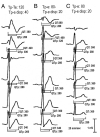Tpeak-Tend and Tpeak-Tend dispersion as risk factors for ventricular tachycardia/ventricular fibrillation in patients with the Brugada syndrome
- PMID: 16682308
- PMCID: PMC1474075
- DOI: 10.1016/j.jacc.2005.12.049
Tpeak-Tend and Tpeak-Tend dispersion as risk factors for ventricular tachycardia/ventricular fibrillation in patients with the Brugada syndrome
Abstract
Objectives: Our objective in this study was to evaluate Tpeak-Tend interval (Tp-e) and other electrocardiographic parameters as risk factors for recurrence of life-threatening cardiac events in patients with the Brugada syndrome (BS).
Background: The Tp-e interval in the electrocardiogram (ECG) has been reported to predict life-threatening arrhythmias in the long QT syndrome.
Methods: Twenty-nine patients with the ECG pattern of BS and 29 healthy age- and gender-matched controls were studied. The follow-up period was 42.65 +/- 24.42 months (range 11 to 108 months).
Results: Upon presentation, five patients had suffered aborted sudden death, five syncope, and two presyncope. Eleven patients with the ECG pattern of BS had a prolonged (>460 ms) QTc in V2 but usually not in inferior or left leads. No patient had abnormally prolonged QT dispersion. Programmed electrical stimulation induced ventricular tachycardia/fibrillation in 5 out of 26 patients. Inducibility did not predict recurrence of events. Cardioverter-defibrillators were implanted in 14 patients (all symptomatic and two asymptomatic). During follow-up, nine symptomatic patients experienced recurrences. Previous cardiac events and a QTc >460 ms in V2 were significant risk factors (p = 0.00002 and p = 0.03, respectively). Tp-e and Tp-e dispersion were significantly prolonged in patients with recurrences versus patients without events (104.4 and 35.6 ms vs. 87.4 and 23.2 ms; p = 0.006 and p = 0.03, respectively) or controls (90.7 and 17.9 ms; p = 0.02 and p = 0.001, respectively).
Conclusions: Our study demonstrates significant correlation between previous events, QTc >460 ms in V2, Tp-e, and Tp-e dispersion and occurrence of life-threatening arrhythmic events, suggesting that these parameters may be useful in risk stratification of patients with the Brugada syndrome.
Figures





References
-
- Brugada P, Brugada J. Right bundle branch block, persistent ST segment elevation and sudden cardiac death: a distinct clinical and electrocardiographic syndrome: a multicenter report. J Am Coll Cardiol. 1992;20:1391–6. - PubMed
-
- Priori SG, Napolitano C, Gasparini M, et al. Clinical and genetic heterogeneity of right bundle branch block and ST-segment elevation syndrome: a prospective evaluation of 52 families. Circulation. 2000;102:2509–15. - PubMed
-
- Eckardt L, Probst V, Smits JP, et al. Long-term prognosis of individuals with right precordial ST-segment-elevation Brugada syndrome. Circulation. 2005;111:257–63. - PubMed
-
- Brugada J, Brugada R, Brugada P. Determinants of sudden cardiac death in individuals with the electrocardiographic pattern of Brugada syndrome and no previous cardiac arrest. Circulation. 2003;108:3092–6. - PubMed
-
- Antzelevitch C, Brugada P, Borggrefe M, et al. Brugada syndrome. Report of the Second Consensus Conference. Endorsed by the Heart Rhythm Society and the European Heart Rhythm Association. Circulation. 2005;111:659–70. - PubMed
Publication types
MeSH terms
Substances
Grants and funding
LinkOut - more resources
Full Text Sources

